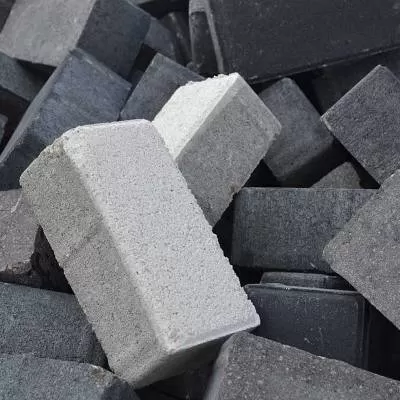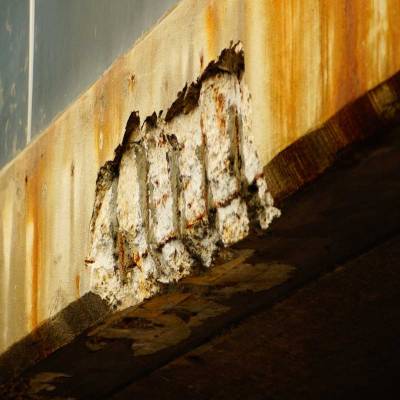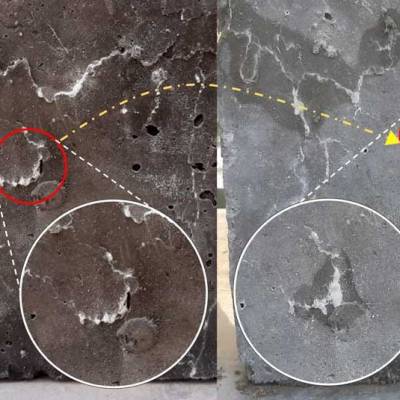- Home
- Building Material
- Concrete
- Mitigating Concrete Cracks
Mitigating Concrete Cracks
In recent years, there has been a continuous increase in the use of mineral admixtures in concrete for higher performance and more durability, or just to decrease the amount of cement used. Such materials, like fly ash and slag, being fine and less reactive than cement, reduce bleeding (i.e., separation of excess water from concrete), which, in general, is good. However, this makes concrete more vulnerable to plastic shrinkage in hot and dry environmental conditions, especially as the early strength of such concretes may be lower.
Consequently, plastic shrinkage cracking is a serious concern nowadays, especially in slabs, decks and pavements. A common complaint among builders and contractors is that floors and slabs crack just after the concrete is placed, especially during hot days. Also, this seems to be occurring more often during the past few years rather than a decade or two earlier. Such cracking causes leakage, and necessitates costly repair and delays during construction. Cracks that appear within a few hours on concrete can be attributed mainly to plastic shrinkage or contraction that occurs owing to high evaporation when the concrete is still wet or plastic. The best way to avoid such cracks is to cure the concrete by covering the surface to reduce evaporation immediately after placing and then to spray or sprinkle water. However, this may not always be possible or done as efficiently as it should be, because of water or labour shortage or simply the logistics. Therefore, we need to assess ways to mitigate the problem.
The assessment
In research led by Prof Ravindra Gettu and Moghul Sirajuddin at the IITM-Lafarge Laboratory for Durability and Long-Term Performance of Concrete, Department of Civil Engineering, IIT - Madras, several concretes were subjected to hot-dry wind in a specially designed chamber to assess the dependence of the cracking on the cements and additives used normally in construction sites in India. The materials were tested in the laboratory by simulating adverse evaporation rates caused by high temperature and wind velocity. Crack mitigation measures such as special shrinkage reducing admixtures and fibres were assessed. Also, the benefit of surface-applied curing compounds on plastic shrinkage crack reduction was studied. The parameters investigated included the rate of evaporation of water from the surface of the concrete, crack initiation time, and crack widths.
The objectives
The study had two major objectives: first, to investigate the influence of supplementary cementitious materials (SCMs) and blended cements on plastic shrinkage cracking; and second, to control plastic shrinkage cracks using shrinkage-reducing admixtures, fibres and curing compounds. Two supplementary cementitious materials-fly ash (Class F) and granulated blast furnace slagùand two blended cements, portland pozzolana cement (PPC) and portland slag cement (PSC), were analysed. The SCMs replaced ordinary portland cement at 15 per cent and 30 per cent by weight, while blended cements completely replaced ordinary portland cement. The binder content and water binder ratio were fixed as 340 kg per cu m and 0.55, respectively, for the entire study. The mix proportions of all the concretes used are provided in Table 1.
What was done?
The control mix (CM) and the mixes with SCMs (FA15, FA30, SG15 and SG30) were first tested and the mix with the highest potential for plastic shrinkage cracking was selected to investigate the efficiency of shrinkage-reducing components and curing compounds. Three slabs were cast for each concrete and exposed to the above-mentioned environmental conditions for 24 hours. The cracked specimens were later allowed to cool for 24 hours. The crack lengths were measured by getting the length of a thread placed along the cracks while the widths were measured at regular intervals of 1 cm along the crack using a handheld microscope. From the measured data, cracking potential is quantified in terms of crack area, length, and maximum and mean widths. For obtaining the crack initiation time, the slabs were visually inspected at intervals of 30 minutes.
The outcome
Results indicate that the addition of supplementary cementitious materials in concrete increases the potential for plastic shrinkage cracking with an increase in their replacement dosage. The incorporation of fly ash and slag at a cement replacement level of 15 per cent increased the crack area by 20 per cent and 120 per cent, respectively. At 30 per cent replacement of fly ash and slag, the crack area further increased by 40 per cent and 300 per cent, respectively. Further, the use of blended cements with fly ash and slag (i.e. PPC and PSC, respectively) resulted in much higher crack areas. Similarly, the crack length, mean crack width and maximum crack width also increased significantly with the replacement of ordinary Portland cement with SCMs and with the use of blended cements.
The benefits of using fibres, glycol-based shrinkage-reducing admixtures (SRAs) at a dosage of 1 per cent and 2 per cent, and different curing compounds at an application rate of 5 sq m per l were evaluated. Polypropylene fibres that are fine and short were effective in limiting cracking when added at a dosage of about 1 kg per cu m of concrete; they cost about Rs 300 per kg and help significantly in saving construction time. The incorporation of SRAs contributed significantly in controlling plastic shrinkage cracking. At a dosage of 1 per cent, the positive effect of the SRA was reflected in the reduction in crack area by 40-65 per cent. At a SRA dosage of 2 per cent, two products completely eliminated cracking while the other two reduced cracking by about 60 per cent. Further, the application of curing compounds on the surface of concrete was found to be useful in controlling cracking by lowering the rate of evaporation. Among the four curing compounds tested, the acrylic-based products eliminated cracking while the other two curing compounds, which were water and wax-based, reduced cracking only by 29 per cent and 44 per cent, respectively. Therefore, shrinkage-reducing admixtures and curing compounds have been found viable for mitigating plastic shrinkage cracking in concretes with supplementary cementitious materials.
Major findings
Guidelines can be formulated for mitigating plastic shrinkage cracking in buildings, roads and slabs.
It is found that concretes that incorporate large amounts of fly ash and slag or PPC, if not cured properly, can experience earlier and more extensive cracking than conventional concretes made only with OPC, if exposed to high evaporation rates.
The most effective way to stop or drastically reduce plastic shrinkage cracking is by mixing about 1 kg of short and fine polypropylene fibres to every cubic metre of concrete.
Other ways to mitigate such cracking is the addition of glycol-based, shrinkage-reducing agents or spraying the fresh concrete with acrylic-based curing compounds to reduce the evaporation of water from the surface.
Proper and prolonged curing (for keeping new concrete moist) is essential to limit cracks and improve durability.
About the Authors:
Dr Ravindra Gettu is the Associate Dean for Consultancy and Sponsored Research, and Professor of Civil Engineering at IIT Madras, Chennai. He is the Vice President of RILEM, the International Union of Laboratories and Experts in Construction Materials, Structures and Systems, based in France, and has consulted for many leading construction materials manufacturers and projects.
Moghul Sirajuddin is a scientist at Aditya Birla Science and Technology Company, Mumbai, and holds a MS degree from IIT Madras. His areas of interest include high performance concrete, fibre reinforced concrete, structural lightweight concrete, effective use of by-products in concrete and durability of concrete.
- Mineral Admixtures
- RAVINDRA GETTU
- MOGHUL SIRAJUDDIN
- Concrete
- Prof Ravindra Gettu
- Moghul Sirajuddin
- IITM-Lafarge Laboratory for Durability
- Long-Term Performance of Concrete
- Department of Civil Engineering
- IIT - Madras
- SCM
- PPC
- PSC
- SRA
- Dr Ravindra Gettu
- Aditya Birla Science
- Technology Company
- Moghul Sirajuddin
- Performance concrete
- Fibre reinforced concrete
- Structural Lightweigh
Concerns of cracks appearing on concrete slab soon after placing are serious. RAVINDRA GETTU and MOGHUL SIRAJUDDIN offer solutions. In recent years, there has been a continuous increase in the use of mineral admixtures in concrete for higher performance and more durability, or just to decrease the amount of cement used. Such materials, like fly ash and slag, being fine and less reactive than cement, reduce bleeding (i.e., separation of excess water from concrete), which, in general, is good. However, this makes concrete more vulnerable to plastic shrinkage in hot and dry environmental conditions, especially as the early strength of such concretes may be lower. Consequently, plastic shrinkage cracking is a serious concern nowadays, especially in slabs, decks and pavements. A common complaint among builders and contractors is that floors and slabs crack just after the concrete is placed, especially during hot days. Also, this seems to be occurring more often during the past few years rather than a decade or two earlier. Such cracking causes leakage, and necessitates costly repair and delays during construction. Cracks that appear within a few hours on concrete can be attributed mainly to plastic shrinkage or contraction that occurs owing to high evaporation when the concrete is still wet or plastic. The best way to avoid such cracks is to cure the concrete by covering the surface to reduce evaporation immediately after placing and then to spray or sprinkle water. However, this may not always be possible or done as efficiently as it should be, because of water or labour shortage or simply the logistics. Therefore, we need to assess ways to mitigate the problem. The assessment In research led by Prof Ravindra Gettu and Moghul Sirajuddin at the IITM-Lafarge Laboratory for Durability and Long-Term Performance of Concrete, Department of Civil Engineering, IIT - Madras, several concretes were subjected to hot-dry wind in a specially designed chamber to assess the dependence of the cracking on the cements and additives used normally in construction sites in India. The materials were tested in the laboratory by simulating adverse evaporation rates caused by high temperature and wind velocity. Crack mitigation measures such as special shrinkage reducing admixtures and fibres were assessed. Also, the benefit of surface-applied curing compounds on plastic shrinkage crack reduction was studied. The parameters investigated included the rate of evaporation of water from the surface of the concrete, crack initiation time, and crack widths. The objectives The study had two major objectives: first, to investigate the influence of supplementary cementitious materials (SCMs) and blended cements on plastic shrinkage cracking; and second, to control plastic shrinkage cracks using shrinkage-reducing admixtures, fibres and curing compounds. Two supplementary cementitious materials-fly ash (Class F) and granulated blast furnace slagùand two blended cements, portland pozzolana cement (PPC) and portland slag cement (PSC), were analysed. The SCMs replaced ordinary portland cement at 15 per cent and 30 per cent by weight, while blended cements completely replaced ordinary portland cement. The binder content and water binder ratio were fixed as 340 kg per cu m and 0.55, respectively, for the entire study. The mix proportions of all the concretes used are provided in Table 1. What was done? The control mix (CM) and the mixes with SCMs (FA15, FA30, SG15 and SG30) were first tested and the mix with the highest potential for plastic shrinkage cracking was selected to investigate the efficiency of shrinkage-reducing components and curing compounds. Three slabs were cast for each concrete and exposed to the above-mentioned environmental conditions for 24 hours. The cracked specimens were later allowed to cool for 24 hours. The crack lengths were measured by getting the length of a thread placed along the cracks while the widths were measured at regular intervals of 1 cm along the crack using a handheld microscope. From the measured data, cracking potential is quantified in terms of crack area, length, and maximum and mean widths. For obtaining the crack initiation time, the slabs were visually inspected at intervals of 30 minutes. The outcome Results indicate that the addition of supplementary cementitious materials in concrete increases the potential for plastic shrinkage cracking with an increase in their replacement dosage. The incorporation of fly ash and slag at a cement replacement level of 15 per cent increased the crack area by 20 per cent and 120 per cent, respectively. At 30 per cent replacement of fly ash and slag, the crack area further increased by 40 per cent and 300 per cent, respectively. Further, the use of blended cements with fly ash and slag (i.e. PPC and PSC, respectively) resulted in much higher crack areas. Similarly, the crack length, mean crack width and maximum crack width also increased significantly with the replacement of ordinary Portland cement with SCMs and with the use of blended cements. The benefits of using fibres, glycol-based shrinkage-reducing admixtures (SRAs) at a dosage of 1 per cent and 2 per cent, and different curing compounds at an application rate of 5 sq m per l were evaluated. Polypropylene fibres that are fine and short were effective in limiting cracking when added at a dosage of about 1 kg per cu m of concrete; they cost about Rs 300 per kg and help significantly in saving construction time. The incorporation of SRAs contributed significantly in controlling plastic shrinkage cracking. At a dosage of 1 per cent, the positive effect of the SRA was reflected in the reduction in crack area by 40-65 per cent. At a SRA dosage of 2 per cent, two products completely eliminated cracking while the other two reduced cracking by about 60 per cent. Further, the application of curing compounds on the surface of concrete was found to be useful in controlling cracking by lowering the rate of evaporation. Among the four curing compounds tested, the acrylic-based products eliminated cracking while the other two curing compounds, which were water and wax-based, reduced cracking only by 29 per cent and 44 per cent, respectively. Therefore, shrinkage-reducing admixtures and curing compounds have been found viable for mitigating plastic shrinkage cracking in concretes with supplementary cementitious materials. Major findings Guidelines can be formulated for mitigating plastic shrinkage cracking in buildings, roads and slabs. It is found that concretes that incorporate large amounts of fly ash and slag or PPC, if not cured properly, can experience earlier and more extensive cracking than conventional concretes made only with OPC, if exposed to high evaporation rates. The most effective way to stop or drastically reduce plastic shrinkage cracking is by mixing about 1 kg of short and fine polypropylene fibres to every cubic metre of concrete. Other ways to mitigate such cracking is the addition of glycol-based, shrinkage-reducing agents or spraying the fresh concrete with acrylic-based curing compounds to reduce the evaporation of water from the surface. Proper and prolonged curing (for keeping new concrete moist) is essential to limit cracks and improve durability. About the Authors: Dr Ravindra Gettu is the Associate Dean for Consultancy and Sponsored Research, and Professor of Civil Engineering at IIT Madras, Chennai. He is the Vice President of RILEM, the International Union of Laboratories and Experts in Construction Materials, Structures and Systems, based in France, and has consulted for many leading construction materials manufacturers and projects. Moghul Sirajuddin is a scientist at Aditya Birla Science and Technology Company, Mumbai, and holds a MS degree from IIT Madras. His areas of interest include high performance concrete, fibre reinforced concrete, structural lightweight concrete, effective use of by-products in concrete and durability of concrete.



















